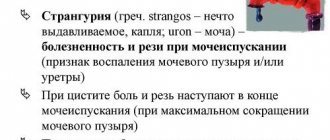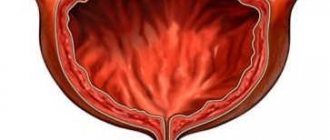Causes of acute urinary retention in children
Phimosis
Congenital phimosis can cause difficulty urinating in young children. Usually, mothers themselves draw the doctor’s attention to this cause of urinary retention - they say that during urination the child tenses up, becomes red, and one can see how his preputial sac is swollen with urine. This occurs because the lumen of the external opening of the preputial sac is narrower than the lumen of the urethra. In case of infection, with acute balanoposthitis , difficulty urinating becomes even more pronounced as a result of swelling of the mucous membrane of the foreskin. Some children experience complete anuria.
Paraphimosis
Acute urinary retention in young children can occur with paraphimosis . The diagnosis is made without difficulty.
Acute cystitis
In young children, acute cystitis often develops in a peculiar way. If acute cystitis in adults is accompanied by a frequent urge to urinate, then in childhood it can cause acute urinary retention. From the stories of the parents, it turns out that the child complains of pain in the lower abdomen, does not urinate, cries when he is given a potty, and holds his penis with his hand (if we are talking about a boy). When trying to palpate the abdomen, a small patient, due to pain, cries and strains the abdominal wall, as a result of which it is not possible to determine the distended bladder. The urine of children with acute cystitis is often blood-stained, which can lead to an erroneous diagnosis of acute nephritis (which is also facilitated by false albuminuria).
Anuria in children with cystitis is explained by pain that is felt during urination. These pains are caused by spasm of the bladder sphincter.
Pathology of the urethra
Urinary retention due to compression of the urethra can occur with tumors arising from the pelvis; Anuria rarely occurs with congenital urethral stricture .
Pathology of the nervous system
Often, urinary retention in children depends on diseases of the nervous system , in particular the spinal cord. Most often this occurs when the spinal cord is compressed in patients with tuberculous spondylitis, spinal trauma, or myelitis. Both urinary retention and incontinence occur in acute meningococcal and tuberculous meningitis. Blum and Gohvard described such cases in two boys aged 13 and 15 years due to foci of poliomyelitis in the sacral spinal cord.
Infectious diseases
In young children, urinary retention can occur due to a number of acute infectious diseases (in these cases, anuria is reflexive and toxic in nature). Thus, cases of diphtheria have been described. Goligorsky S.D. The following clinical case was observed, which led to a diagnostic error by an experienced pediatrician.
Child B., 4 months old, was sent to a children's hospital due to malnutrition. The patient was in serious condition. I haven't urinated for the last 24 hours. During his examination, the pediatrician determined that the bladder was sharply distended, reaching the navel, and on this basis referred the patient to the urology department, where his bladder was emptied using catheterization. It turned out that there were no anatomical changes in the urethra, and no stones were found. The child had bronchopneumonia. A day later, when his condition improved due to the administration of antibiotics, urination was restored.
Reflex reasons
Reflex urinary retention in children occurs with acute appendicitis , helminthic infestation (for example, with ascariasis or strongyloidiasis).
Causes
As soon as difficulties arise with urine output, you need to contact a specialist. The following illnesses can cause difficulty urinating in a teenager:
- cystitis or urethritis of any form;
- neurogenic bladder dysfunction;
- spasm of the urethral sphincter due to neurological pathologies;
- when the walls of the bladder are irritated by salts and sand;
- for inflammatory kidney diseases;
- congenital developmental anomalies that appeared during puberty;
- endocrine diseases affecting the adrenal glands, thyroid gland, pituitary gland;
- metabolic disorders (diabetes mellitus);
- hormonal disruptions, which are observed in adolescents;
- migraines with spasms of blood vessels in the neck and head;
- neoplasms affecting the urinary system;
The above reasons apply to both sexes. If we talk about girls, then the following factors should be added:
- developmental anomalies when uterine bending is diagnosed;
- gynecological diseases, most often adnexitis;
- inflammation of the pelvic organs.
When using some drugs, side effects may occur that affect the condition of the urethra and sphincters. Especially when it comes to sleeping pills and tranquilizers. Diuretic medications can also have an effect if they are prescribed incorrectly or if they are taken without the supervision of a specialist.
The urethra can become blocked for a variety of reasons. Either during medical procedures or due to injury. Increased pressure in the peritoneum sometimes causes difficulty urinating in a teenager.
As for other reasons not related to diseases, the following are usually identified:
- hormonal changes that always accompany adolescence;
- spasms due to emotional stress;
- hypothermia of the body, causing spasms of the urethra (reflex);
- constant stress and tension;
- postponing a visit to the toilet, causing overextension and reflex spasm;
- the predominance of spicy, sour, salty and sour foods in food that irritate the bladder;
Features by gender
The urethra in boys is narrow but long. At the entrance is the prostate gland, which protects the genitourinary system from infections. In girls, like in women, the urethra is wider and shorter. The infection rises fairly quickly, causing inflammation.
Difficulty urinating in a teenager is often diagnosed when the urethra is swollen due to a bacterial infection. Inflammation causes swelling of the mucous membrane, making it difficult for urine to come out. At the same time, pain and stinging appear, and the body temperature also rises. Unpleasant sensations usually occur at the beginning and end of urination.
If we talk about girls, then every month they may experience changes due to hormonal fluctuations caused by the menstrual cycle. The uterus and bladder are “neighbors.” Next to them is the intestines. That is why, when investigating a problem, a complete examination should be carried out.
In addition, early sexual life makes its own adjustments. In addition to infection, the body adapts to new conditions and the urinary system may respond with problems with urination. This especially happens immediately after sexual intercourse.
Causes of chronic urinary retention in children
Chronic urinary retention in children may result from sclerosis of the bladder neck . This diagnosis is supported by the absence of signs of other diseases with similar urological symptoms:
- changes in urethral patency,
- inflammatory process in the urinary tract,
- signs of spinal cord damage, etc.
Still, the most common cause of urinary retention in children is urolithiasis . A calculus stuck in the lumen of the urethra causes spasm and, as a result, anuria. The diagnosis is made on the basis of anamnesis (complaints of pain in the head of the penis, intermittency of the stream), palpation of the accessible part of the urethra, and examination of its patency. When examined with a children's metal catheter or bougie, a characteristic sensation of a stone in the lumen of the urethra is obtained.
Enuresis in children - what is important for parents to know
Watching their baby grow up, all parents look forward to the moment when he begins to go to the potty on his own, and the era of wet diapers and panties finally ends. But approximately every tenth family has to deal with some kind of urination disorder in their child. The most famous and common problem is ENURESIS.
Enuresis
– this is involuntary urination during sleep in children over 4-5 years old. Doctors make this diagnosis after 4 years, when full control of the act of urination occurs with any filling of the bladder. The child can urinate on his own even without the urge to urinate, interrupt urination, and involuntary loss of urine stops both during the day and at night. From this age, regular urinary incontinence is considered pathological and the child requires examination and treatment.
Enuresis can be either an independent disease or a symptom of a more complex organic or functional pathology of the genitourinary system.
In 5-year-old children, enuresis occurs in 16.1% of cases, in 9-year-old children - 3.1% of cases, and in adolescents - 1%. Boys are 2-3 times more likely than girls. Enuresis is more common if one or both parents suffered from bedwetting. The risk of disease increases by 45 and 75%, respectively. At 5-7 years of age, mild forms of enuresis predominate (when the child wakes up wet 1-2 times a week), but with age the number of severe forms increases (wet all nights). Therefore, diagnosis and timely treatment of enuresis in a child is an important task facing doctors and parents.
You will learn from this article about why bedwetting occurs and how it manifests itself, what are the principles of its diagnosis and treatment, including physiotherapeutic techniques.
Bedwetting is primary
and
secondary
. From the name it is clear that primary enuresis occurs at an early age, while the bed is wet almost every night, without noticeable dry intervals. With secondary enuresis, there may be significant periods of dry nights, at least 6 months, and then the problem returns. Often secondary enuresis is associated with psychogenic causes and accounts for up to 15-20% of all enuresis in children.
Enuresis is also divided into monosymptomatic
and
non-monosymptomatic
.
The majority of all enuresis is monosymptomatic enuresis - enuresis in the absence of any other symptoms of the lower urinary tract. Antidiuretic hormone or vasopressin plays an important role in monosymptomatic enuresis.
. This hormone of the pituitary gland, acting on the kidneys, increases the concentration of urine and reduces its volume.
The production of vasopressin is subject to the circadian rhythm (biological daily rhythm with alternation of sleep and wakefulness) and normally increases at night when the child is sleeping. In most children, the hypothalamic-pituitary system matures by the age of 4-5 years. In those children in whom the circadian pattern of vasopressin production does not have time to form, its concentration in the blood does not increase at night or does not increase sufficiently, this leads to the fact that urine production at night does not decrease, and in combination with a small functional capacity of the bladder and sound sleep (child does not wake up when his bladder is full) leads to enuresis.
Non-monosymptomatic enuresis is a combination of nocturnal problems with urination with symptoms of the lower urinary tract: sudden strong urge (urgency), frequent urination, daytime urinary incontinence, urinary dysfunction
The causes of non-monosymptomatic enuresis are quite varied.
- Delayed maturation of the central nervous system
- Congenital spinal cord defects
- Urinary tract infections
- Malformations and anomalies of the urinary system
- Neurogenic bladder dysfunctions
- Adenoids, episodes of sleep apnea
- Constipation
Accordingly, in order to correctly establish the cause of bedwetting, the child must be comprehensively examined not only from the urinary system, but also necessarily examined by a neurologist, and, if necessary, an ENT doctor, gastroenterologist, gynecologist, or psychotherapist.
The standard examination of children with enuresis must include:
- examination and consultation with a urologist and neurologist;
- urine and blood tests;
- filling out a urination diary;
- Ultrasound of the kidneys and bladder.
In the future, if necessary, the examination can be supplemented with more complex methods:
- uroflowmetry;
- complex urodynamic examination (CUDI);
- electromyography of the muscles of the perineum and lower extremities;
- X-ray methods (spinal x-ray, intravenous urography, cystography), etc.
In accordance with the identified pathology, treatment is subsequently prescribed by a doctor of the appropriate specialty.
Treatment of any form of enuresis begins with UROTHERAPY
. Urotherapy is a system of cognitive methods aimed at developing a child’s correct relationship with the potty. The child must be informed about the problem. It happens that children are brought to an appointment who do not attach any importance or do not even know that they pee at night. Parents hide it - change clothes, change underwear, absorbent diapers, so as not to injure the child.
Of course, you cannot scold a child. It is best to have a calendar where the baby will mark the days when he woke up wet or dry (draw, for example, a cloud or the sun), and when he has a certain number of dry days in a row, receive some kind of encouragement.
It is also possible to use urine alarms. When the first drops hit the sheet or linen, the urine alarm wakes the child up. However, due to the fact that enuresis is often associated with pathologically deep sleep in children, this method does not always give the expected effect. The alarm clock wakes up everyone around except the baby himself.
It is important to maintain a drinking regime and limit fluid intake 1.5 - 2 hours before bedtime. It is necessary to optimize sleep and wakefulness, reduce additional stress in order to reduce fatigue during the day. Due to the frequent combination of enuresis in children with constipation, it is necessary to monitor the regularity of bowel movements; constipation, if any, should be eliminated.
If urotherapy does not give the desired result and the child is suspected of having monosymptomatic enuresis, the doctor may consider treatment with vasopressin analogues, if there are indications for this. The drug is prescribed according to certain regimens with gradual withdrawal thereafter. During treatment, the patient's own vasopressin production system matures and enuresis stops. In case of resumption of enuresis after the end of treatment, the course is repeated.
To normalize the physiological support of the act of urination, various options for physiotherapy
.
In case of violation of urination control, biofeedback therapy
(biofeedback method). Electrodes are attached to the child's perineum, which record the movements of the pelvic floor and in a playful way the child learns to correctly tense and relax the necessary muscles in order to urinate correctly.
Neurologists can actively prescribe neurotrophic drugs and nootropics in parallel.
The last resort is to resort to more serious drugs that inhibit the activity of the bladder (M-cholinergic blockers) or to methods of temporary chemodenervation (injections of botulinum toxin into the wall of the bladder).
The XXI Century Medical Center has all the diagnostic and treatment capabilities to solve the problem of enuresis and specialists who work in depth with it.
The advantage of a multidisciplinary center is that one patient is jointly observed by a urologist and a neurologist, if necessary, involving other specialists, exchanging information and jointly finding effective solutions. You can make an appointment with a specialist at our center by phone





